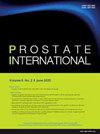Anterior versus posterior first approach for robot assisted radical prostatectomy-perioperative, functional, and oncological outcomes
IF 2.6
2区 医学
Q2 UROLOGY & NEPHROLOGY
引用次数: 0
Abstract
Background
Robot-assisted radical prostatectomy (RARP) is commonly performed using either the anterior (AF) or posterior first (PF) approaches, depending upon where the dissection begins. While there is some data comparing outcomes of conventional RARP and Retzius sparing posterior RARP, there is limited data comparing outcomes between the AF and PF approaches to conventional RARP. We compared the two approaches in terms of perioperative, functional, and oncological outcomes.
Materials and methods
We retrospectively reviewed our data of RARP performed between 2014 and 2023 and identified 258 patients who had undergone the procedure using one of the two approaches. The choice of approach was dependent upon the surgeon with five surgeons with varying experience having performed all surgeries. We compared the two cohorts for perioperative, functional, and oncological outcomes.
Results
One hundred thirty-nine patients underwent RARP using the AF approach and 119 the PF approach. AF group were younger and had larger prostate volume at baseline. Operative time, blood loss was higher in the PF approach, whereas the positive surgical margins, biochemical recurrence, need for adjuvant therapy, potency, and continence parameters were similar between the two groups.
Conclusions
Our data suggests that the AF approach offers certain advantages in operative outcomes in RARP. However, this could be due to surgeon experience and needs better-controlled studies for validation.
机器人辅助根治性前列腺切除术的前路与后路第一入路:围手术期、功能和肿瘤预后
机器人辅助根治性前列腺切除术(RARP)通常采用前路(AF)或后路(PF)入路,这取决于剥离开始的位置。虽然有一些数据比较传统RARP和Retzius保留后路RARP的结果,但比较AF和PF入路与传统RARP的结果的数据有限。我们在围手术期、功能和肿瘤预后方面比较了两种方法。材料和方法我们回顾性地回顾了2014年至2023年间进行的RARP的数据,并确定了258例使用两种方法之一进行手术的患者。入路的选择取决于外科医生,有5位外科医生有不同的手术经验。我们比较了两个队列的围手术期、功能和肿瘤预后。结果39例患者采用AF入路行RARP, 119例采用PF入路。房颤组患者较年轻,基线时前列腺体积较大。PF入路的手术时间、出血量更高,而两组的阳性手术切缘、生化复发、辅助治疗需求、效力和失禁参数相似。结论AF入路在RARP手术效果上有一定优势。然而,这可能是由于外科医生的经验,需要更好的对照研究来验证。
本文章由计算机程序翻译,如有差异,请以英文原文为准。
求助全文
约1分钟内获得全文
求助全文
来源期刊

Prostate International
Medicine-Urology
CiteScore
4.40
自引率
26.70%
发文量
40
审稿时长
35 days
期刊介绍:
Prostate International (Prostate Int, PI), the official English-language journal of Asian Pacific Prostate Society (APPS), is an international peer-reviewed academic journal dedicated to basic and clinical studies on prostate cancer, benign prostatic hyperplasia, prostatitis, and ...
 求助内容:
求助内容: 应助结果提醒方式:
应助结果提醒方式:


